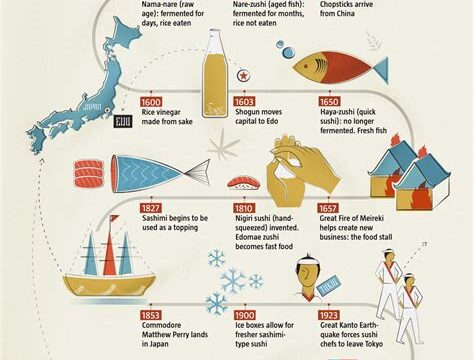Ancient Origins: The Beginnings of Sushi
Sushi is a beloved and globally recognized Japanese cuisine that has a rich and fascinating history. Dating back thousands of years, its origins can be traced to ancient times when it was first developed as a preservation method for fish. The evolution of sushi has seen it undergo numerous transformations, eventually becoming the culinary art form we know today. Let’s dive deeper into the ancient origins of sushi and explore the journey it has taken throughout history.
The story of sushi begins in Southeast Asia, where the concept of preserving fish with fermented rice was first conceived. This early form of sushi was known as narezushi and was introduced in Japan around the 8th century. The preservation process involved packing fish in layers of cooked rice and salt, which allowed the fish to ferment over time. However, it was primarily used as a method to preserve fish rather than to be consumed as a delicacy.
During the Muromachi period in Japan (1333-1573), narezushi underwent a significant transformation. The rice used for preservation began to be discarded, and it was during this time that the term “sushi” first emerged. The focus shifted from the preservation aspect to the taste and flavor of the fish itself. This marked the transition from narezushi to what is known as haya-zushi, where the fish was no longer fermented and could be consumed quickly.
As time went on, haya-zushi continued to evolve, and in the Edo period (1603-1868), a game-changing sushi innovation emerged: nigiri-zushi. Nigiri, meaning “to grasp,” referred to the technique of shaping rice and fish into small bite-sized pieces. This revolutionary approach elevated sushi to a new level, as it allowed for the delicate balance of rice, fish, and seasoning. Nigiri-zushi marked a significant turning point in sushi’s history, as it set the foundation for the sushi we enjoy today.
Throughout centuries, sushi has gradually gained popularity beyond Japan’s shores. It wasn’t until the late 19th century that sushi started to spread beyond Japan, as Tokyo, formerly known as Edo, became the epicenter of its culinary development. The city’s vibrant food culture and bustling fish market played a vital role in introducing sushi to the world. As the art of sushi-making spread, it underwent further innovations and adaptations in different regions, leading to the diverse range of sushi styles we see today.
The ancient origins of sushi have laid the foundation for a culinary tradition that has captured the hearts and taste buds of people around the world. From its humble beginnings as a preservation technique to its transformation into an artistic delicacy, sushi continues to evolve and inspire. Exploring the rich history of sushi allows us to appreciate its cultural significance and the centuries of craftsmanship that have shaped it into the beloved cuisine it is today.
- Ancient origins of sushi
- Evolution from narezushi to haya-zushi
- Nigiri-zushi: A game-changer in sushi history
- Sushi spreading beyond Japan
- Diverse sushi styles around the world
| Period | Sushi Style |
|---|---|
| Ancient Times | Narezushi |
| Muromachi Period | Haya-zushi |
| Edo Period | Nigiri-zushi |
Evolution of Sushi: From Fermented Fish to Edible Art
The evolution of sushi has been a fascinating journey that spans hundreds of years and showcases the ingenuity and creativity of the Japanese culture. From its humble beginnings as a method of preserving fish to its modern-day status as a culinary art form, sushi has come a long way. In this blog post, we will explore the evolution of sushi and how it has transformed from fermented fish to an edible art.
In ancient times, people in Southeast Asia discovered that fermenting fish with salt and rice allowed them to eat the fish even when it was no longer fresh. This method of preservation helped sustain their diets and provided them with a valuable source of protein. Over time, this technique of fermentation made its way to Japan and became the foundation for what we now know as sushi.
The next major development in the evolution of sushi was the invention of vinegared rice. It is believed that during the Muromachi period (AD 1336-1573), cooks in Japan began using rice vinegar to season the rice that accompanied the fermented fish. This added a tangy flavor to the dish and helped to balance the taste of the preserved fish. This was a game-changer in sushi history, as it transformed the dish into something more palatable and enjoyable.
- Relevant keywords: evolution of sushi, fermented fish, edible art, preserving fish, culinary art form, sushi history, ancient times, Southeast Asia, preserving diets, protein, fermentation, preservation, vinegared rice, Muromachi period, rice vinegar, tangy flavor, palatable, enjoyable.
The next major advancement in the evolution of sushi came during the Edo period (1603-1868), when Tokyo, then known as Edo, became the epicenter of sushi innovation. During this time, sushi began to be served as street food by sushi stalls and food vendors. The introduction of nigiri sushi was a defining moment in sushi history. Nigiri sushi is made by placing a slice of raw fish on top of a small mound of vinegared rice. This method allowed the flavors of the fish and rice to meld together, creating a harmonious taste experience.
As sushi’s popularity grew, so did the variety of ingredients used in its preparation. Chefs began experimenting with different types of fish, seafood, and vegetables to create unique flavor combinations. Additionally, sushi rolls such as maki rolls and temaki (hand rolls) were introduced, offering a convenient and portable way to enjoy sushi. The addition of soy sauce, wasabi, and pickled ginger as condiments further enhanced the flavors and textures of sushi.
| Sushi Types | Description |
|---|---|
| Nigiri sushi | Raw fish placed on top of a small mound of vinegared rice. |
| Maki sushi | Seaweed wrapped around vinegared rice and various fillings. |
| Temaki sushi | Hand-rolled sushi with a cone shape, filled with rice and ingredients. |
In recent years, sushi has evolved into a form of edible art, with skilled sushi chefs using their creativity and precision to craft intricate and visually appealing pieces. These artistic creations, known as omakase, are often presented as a tasting menu where the chef selects the freshest ingredients and showcases their flavors in a carefully curated sequence of dishes. Sushi has also embraced fusion cuisine, incorporating ingredients and flavors from other culinary traditions to create innovative and unique sushi experiences.
While sushi has certainly come a long way from its origins as a method of preserving fish, it still retains its cultural significance and traditions. Sushi etiquette, such as using chopsticks or hands to eat sushi and the proper way to dip sushi into soy sauce, continues to be followed to this day. Additionally, sustainability has become an important aspect of sushi, with efforts to source seafood responsibly and reduce environmental impact.
The evolution of sushi from fermented fish to edible art is a testament to the creativity and adaptability of Japanese cuisine. This beloved culinary tradition continues to captivate people around the world with its unique flavors, beautiful presentations, and cultural significance.
- Relevant keywords: Edo period, Tokyo, nigiri sushi, flavor combinations, sushi rolls, maki rolls, temaki, soy sauce, wasabi, pickled ginger, condiments, sushi types, vinegared rice, art form, edible art, sushi chefs, omakase, fusion cuisine, cultural significance, sushi etiquette, sustainability, Japanese cuisine, unique flavors, beautiful presentations.
The Birth of Nigiri: A Game-Changer in Sushi History
Sushi, a popular Japanese cuisine, has a long and intriguing history. With its origins tracing back to ancient times, sushi has evolved over the centuries, undergoing various transformations and innovations. One significant milestone in sushi’s history is the birth of nigiri, a game-changer that revolutionized the way sushi was prepared and enjoyed.
Nigiri sushi, also known as hand-pressed sushi, is a style of sushi that originated in the 19th century in Edo (present-day Tokyo). The word “nigiri” means “gripping” or “squeezing,” referring to the technique used to form the sushi. Unlike its predecessors which were primarily fermented fish combined with rice, nigiri introduced a new way of presenting sushi by placing a small piece of fresh, raw fish on a small mound of vinegared rice.
This ingenious innovation not only enhanced the flavors and textures of sushi but also showcased the natural beauty and freshness of the fish. The introduction of nigiri marked a turning point in sushi history, as it shifted the focus from the preservation of fish to the celebration of its quality and taste. The simplicity and elegance of nigiri quickly gained popularity and laid the foundation for modern sushi as we know it today.
- Taste: Nigiri sushi offers a harmonious blend of flavors, with the umami-rich fish complementing the slightly tangy and seasoned rice.
- Texture: The combination of the soft, slightly sticky rice and the delicate, melt-in-your-mouth fish creates a delightful contrast in textures.
- Presentation: Nigiri sushi is visually appealing, with the vibrant colors of the fish contrasting against the white rice. The skillful craftsmanship of the sushi chef is often evident in the perfectly shaped and arranged pieces.
| Ingredients | Preparation | Presentation |
|---|---|---|
| Fresh, high-quality fish (e.g., tuna, salmon, yellowtail) | Season the fish with soy sauce, wasabi, or other condiments. Prepare seasoned rice by mixing vinegar, sugar, and salt with cooked sushi rice. | Place a small amount of prepared rice into the chef’s hand. Top it with a slice of fish and shape it into a compact, fingertip-sized piece. Garnish as desired. |
| Sushi rice (short-grain rice seasoned with vinegar, sugar, and salt) | ||
| Wasabi (Japanese horseradish) | ||
| Soy sauce and pickled ginger (for dipping and cleansing the palate) |
Today, nigiri sushi has become one of the most popular and sought-after sushi styles worldwide. Whether enjoyed at traditional sushiya (sushi restaurants) or trendy sushi bars, the legacy of nigiri lives on as a testament to the continuous evolution and innovation within the culinary world. So the next time you indulge in a piece of nigiri, remember the historical significance behind this game-changing sushi creation.
Sushi Spreads: The Journey from Tokyo to the World
The journey of sushi from its humble beginnings in Tokyo to becoming a global culinary phenomenon is nothing short of fascinating. Sushi, which means “sour-tasting” in Japanese, originated as a way to preserve fish by fermenting it with rice. Over time, this preservation method evolved, giving birth to various types of sushi that are now enjoyed worldwide.
One of the key milestones in the spread of sushi was the invention of nigiri sushi in the early 19th century. Nigiri, which means “hand-pressed,” revolutionized sushi by combining bite-sized portions of fresh fish with a small mound of vinegared rice. This innovation made sushi more accessible and convenient to eat, paving the way for its popularity not only in Tokyo but also beyond its borders.
Sushi truly started to gain international recognition during the mid-20th century, when Japan emerged as an economic powerhouse after World War II. As Tokyo blossomed into a bustling metropolis, sushi became a symbol of Japanese culture and sophistication. Visitors from around the world flocked to Tokyo to experience authentic sushi, and as they returned home, they brought with them tales of this delectable cuisine.
- Exploding popularity of sushi in the United States in the 1960s
- The advent of sushi bars and restaurants in major cities worldwide
- The incorporation of local ingredients and flavors into sushi recipes
The popularity of sushi soared in the 1960s when it made its way to the United States. Initially, sushi was met with skepticism and apprehension due to its raw fish component. However, innovative chefs found ways to adapt sushi to suit the Western palate, introducing cooked variations and adding ingredients such as avocado and cream cheese.
The rise of sushi bars and restaurants in major cities outside of Japan also played a significant role in spreading its popularity. From New York to London, sushi establishments began to appear, offering not only traditional sushi but also modern interpretations and creative fusions. Sushi became a staple in the dining scene, attracting both locals and tourists alike.
Sustainability also became an important aspect of sushi’s journey to the world. As concerns about overfishing and environmental conservation grew, sushi chefs and enthusiasts started to focus on sustainable sourcing of fish and seafood. This led to initiatives promoting responsible fishing practices and the use of alternative ingredients to reduce the impact on marine ecosystems.
| Sushi Tradition | Sushi Innovation |
|---|---|
| Preservation method using fermented fish | Introduction of nigiri sushi |
| Symbol of Japanese culture | Adaptation to suit Western palate |
| Authentic Tokyo sushi experience | Global proliferation of sushi bars |
| Sustainable sourcing of fish | Use of alternative ingredients |
In conclusion, the journey of sushi from Tokyo to the world is a testament to its enduring appeal and adaptability. From its ancient origins as a preservation method to becoming a global culinary phenomenon, sushi has undergone remarkable transformations and adaptations throughout history. As sushi continues to evolve and innovate, one thing is certain – its delicious flavors and cultural significance will continue to captivate taste buds around the globe.
Sushi Etiquette: Cultural Significance and Traditions
Sushi is not just a food, but a cultural tradition that holds great significance in Japanese society. It is not simply about how the sushi is made or the ingredients used, but also about the way it is consumed and the customs associated with it. Sushi etiquette plays a vital role in preserving the authenticity of this beloved Japanese cuisine and ensuring a respectful dining experience for both the sushi chef and the customers.
One of the most important aspects of sushi etiquette is showing respect to the sushi chef. In Japan, the sushi chef is considered a master craftsman and is highly respected. When dining at a sushi restaurant, it is customary to greet the chef with a simple bow and express gratitude for their culinary skills. This gesture not only shows appreciation for the chef’s expertise but also sets the tone for a harmonious dining experience.
Another key aspect of sushi etiquette is the correct way to eat sushi. Sushi is traditionally eaten with the fingers rather than using chopsticks. Using your hands allows you to fully experience the texture and temperature of the sushi. It is important to dip the sushi into soy sauce fish-side down to avoid overpowering the delicate flavors of the fish. A small amount of wasabi can be added to the fish, but it should be done sparingly so as not to mask the natural taste of the sushi.
- 1. Chopsticks: While sushi is primarily eaten with the fingers, it is acceptable to use chopsticks if you prefer. However, keep in mind that sushi is meant to be enjoyed in one bite, so be sure to choose an appropriate amount that can fit comfortably in your mouth.
- 2. Ordering: When ordering sushi at a traditional sushi bar, it is best to follow the omakase style, which means entrusting the chef to select the freshest and most flavorful pieces of sushi for you. This allows the chef to showcase their skills and expertise in creating a balanced and satisfying sushi experience.
- 3. Talking: While it is common to engage in conversation during a meal, it is important to keep noise to a minimum in a sushi restaurant. The focus should be on the sushi and the overall dining experience. Lower your voice and avoid disruptive behavior out of respect for the chef and other diners.
Sushi etiquette is not just about following a set of rules, but about appreciating the traditions and customs associated with this ancient culinary art. By observing proper etiquette, we can gain a deeper understanding and respect for the cultural significance of sushi. So, the next time you indulge in this delightful Japanese cuisine, remember to show your admiration and appreciation for the sushi chef and savor each bite with reverence and respect.
Modern Sushi Techniques: Fusion and Innovation
Sushi has come a long way since its humble beginnings. What started as a simple way to preserve fish has evolved into a culinary art form that is celebrated around the world. One of the driving forces behind the evolution of sushi is the constant pursuit of new techniques and flavors. In this blog post, we will explore the modern sushi techniques that have emerged in recent years, showcasing the fusion of different culinary traditions and the innovative ideas that have revolutionized the sushi industry.
One of the most prominent modern sushi techniques is the fusion of different culinary traditions. Sushi chefs are constantly experimenting with new ingredients and flavors, drawing inspiration from cuisines around the world. This fusion of flavors has led to the creation of unique sushi rolls that feature diverse ingredients such as avocado, cream cheese, and even mayonnaise. By incorporating these unexpected ingredients, sushi chefs are able to create a harmonious blend of flavors that tantalize the taste buds and offer a new experience for sushi enthusiasts.
In addition to the fusion of flavors, innovation plays a key role in modern sushi techniques. Sushi chefs are continuously pushing the boundaries of traditional sushi-making methods, exploring new ways to present and serve sushi. One example of this innovation is the use of molecular gastronomy techniques, such as encapsulation and spherification. These techniques allow chefs to create visually striking dishes that not only taste delicious but also showcase their creative prowess. By incorporating these innovative techniques, sushi chefs are able to elevate sushi from a simple bite to a work of art.
- The fusion of different culinary traditions
- The use of unexpected ingredients
- The incorporation of molecular gastronomy techniques
| Technique | Description |
|---|---|
| Fusion of flavors | Sushi chefs experiment with new ingredients and draw inspiration from cuisines around the world |
| Incorporation of unexpected ingredients | Sushi rolls feature diverse ingredients such as avocado, cream cheese, and mayonnaise |
| Innovation through molecular gastronomy | Chefs use encapsulation and spherification techniques to create visually striking dishes |
Sustainability and Sushi: Balancing Tradition and Conservation
Sushi is not only a culinary delight but also a reflection of a rich cultural heritage. As this traditional Japanese cuisine continues to gain popularity worldwide, it is important to address the issue of sustainability and conservation. With concerns about overfishing and environmental impact on marine ecosystems, sushi lovers and industry professionals alike are now advocating for responsible fishing practices and sustainable sourcing of ingredients.
Sushi has a long history that stretches back centuries, and its evolution is intertwined with the principles of balance and harmony. Traditional sushi emphasizes the use of fresh, seasonal ingredients, often sourced locally. This not only ensures the highest quality and flavor but also reduces the carbon footprint associated with long-distance transportation. By supporting local fishermen and suppliers, sushi lovers can contribute to the preservation of traditional fishing communities and their way of life.
While traditional sushi remains the epitome of culinary artistry, modern sushi techniques have also emerged, incorporating fusion and innovation. Chefs are experimenting with new flavors and ingredients, pushing the boundaries of traditional sushi while still maintaining a focus on sustainability. For example, sustainable alternatives to traditional seafood choices, such as plant-based sushi rolls or responsibly farmed fish, are becoming more widespread.
- Sustainable sourcing: To support conservation efforts, many sushi restaurants now prioritize working with suppliers who follow sustainable fishing practices. This includes avoiding species that are overfished or at risk of extinction, as well as using fishing methods that minimize bycatch and habitat destruction.
- Reducing food waste: Sushi chefs are increasingly conscious of food waste and are finding innovative ways to repurpose ingredients. Unused portions of fish, for example, can be used in other dishes or made into stock, minimizing waste and maximizing the use of every part of the fish.
- Education and awareness: Raising awareness about the importance of sustainable sushi is key to fostering a lasting change. Restaurants can play a vital role in educating their customers about the significance of responsible sourcing and the impact of their choices on the environment.
As sushi continues to evolve, finding a balance between tradition and conservation is crucial. By embracing sustainable practices, we can preserve the artistry and cultural heritage of sushi for generations to come. So, the next time you indulge in a sushi feast, remember to choose responsibly sourced ingredients and support the restaurants that prioritize sustainability.
Frequently Asked Questions
1. What are the origins of sushi?
Sushi originated in Southeast Asia where it was first developed as a means of preserving fish through fermentation.
2. How has sushi evolved over time?
From its humble beginnings as fermented fish, sushi has evolved into a culinary art form known for its exquisite presentation and flavors.
3. When was nigiri sushi introduced?
Nigiri sushi emerged in the 19th century as a game-changer in sushi history, revolutionizing the way sushi was made and enjoyed.
4. How did sushi spread from Tokyo to the rest of the world?
Sushi gained popularity in Tokyo during the Edo period and gradually spread to other parts of Japan before becoming an international phenomenon.
5. What cultural significance and traditions are associated with sushi?
Sushi etiquette holds great importance in Japanese culture, emphasizing respect for the chef, the food, and the overall dining experience.
6. How have modern techniques influenced the art of sushi-making?
Modern sushi techniques have brought fusion and innovation to traditional sushi, introducing unique flavor combinations and creative preparations.
7. Is sustainability taken into account in the world of sushi?
As sushi continues to gain popularity worldwide, there is a growing focus on balancing tradition and conservation to ensure the sustainable future of this beloved cuisine.





